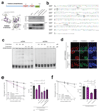Shieldin complex promotes DNA end-joining and counters homologous recombination in BRCA1-null cells
- PMID: 30022119
- PMCID: PMC6145444
- DOI: 10.1038/s41556-018-0140-1
Shieldin complex promotes DNA end-joining and counters homologous recombination in BRCA1-null cells
Abstract
BRCA1 deficiencies cause breast, ovarian, prostate and other cancers, and render tumours hypersensitive to poly(ADP-ribose) polymerase (PARP) inhibitors. To understand the resistance mechanisms, we conducted whole-genome CRISPR-Cas9 synthetic-viability/resistance screens in BRCA1-deficient breast cancer cells treated with PARP inhibitors. We identified two previously uncharacterized proteins, C20orf196 and FAM35A, whose inactivation confers strong PARP-inhibitor resistance. Mechanistically, we show that C20orf196 and FAM35A form a complex, 'Shieldin' (SHLD1/2), with FAM35A interacting with single-stranded DNA through its C-terminal oligonucleotide/oligosaccharide-binding fold region. We establish that Shieldin acts as the downstream effector of 53BP1/RIF1/MAD2L2 to promote DNA double-strand break (DSB) end-joining by restricting DSB resection and to counteract homologous recombination by antagonizing BRCA2/RAD51 loading in BRCA1-deficient cells. Notably, Shieldin inactivation further sensitizes BRCA1-deficient cells to cisplatin, suggesting how defining the SHLD1/2 status of BRCA1-deficient tumours might aid patient stratification and yield new treatment opportunities. Highlighting this potential, we document reduced SHLD1/2 expression in human breast cancers displaying intrinsic or acquired PARP-inhibitor resistance.
Conflict of interest statement
Competing financial interests
SPJ receives some research funding from AstraZeneca and is a named inventor on patents describing the use of PARP inhibitors in cancer therapy. VS’s laboratory receives research funding support from AstraZeneca. MJO and ZL, are employees and shareholders of AstraZeneca. The other authors declare no competing financial interests.
Figures







Comment in
-
Assembling a protective shield.Nat Cell Biol. 2018 Aug;20(8):862-863. doi: 10.1038/s41556-018-0152-x. Nat Cell Biol. 2018. PMID: 30050117 Free PMC article. No abstract available.
References
-
- Goldstein M, Kastan MB. The DNA damage response: implications for tumor responses to radiation and chemotherapy. Annu Rev Med. 2015;66:129–143. - PubMed
-
- Schwertman P, Bekker-Jensen S, Mailand N. Regulation of DNA double-strand break repair by ubiquitin and ubiquitin-like modifiers. Nat Rev Mol Cell Biol. 2016;17:379–394. - PubMed
-
- Blackford AN, Jackson SP. ATM, ATR, and DNA-PK: The Trinity at the Heart of the DNA Damage Response. Mol Cell. 2017;66:801–817. - PubMed
-
- Bekker-Jensen S, Mailand N. Assembly and function of DNA double-strand break repair foci in mammalian cells. DNA Repair (Amst) 2010;9:1219–1228. - PubMed
Publication types
MeSH terms
Substances
Grants and funding
LinkOut - more resources
Full Text Sources
Other Literature Sources
Medical
Research Materials
Miscellaneous

